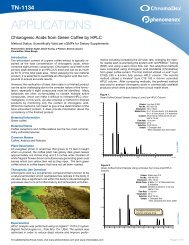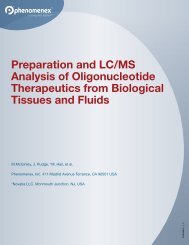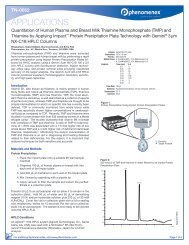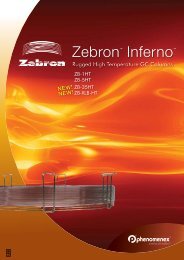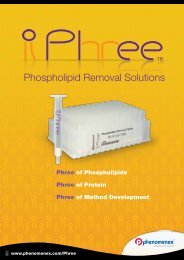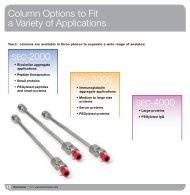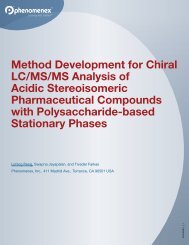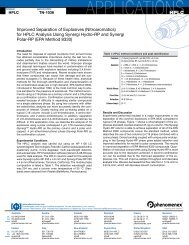Trends in Chiral Large Scale Purification Solutions ... - Phenomenex
Trends in Chiral Large Scale Purification Solutions ... - Phenomenex
Trends in Chiral Large Scale Purification Solutions ... - Phenomenex
You also want an ePaper? Increase the reach of your titles
YUMPU automatically turns print PDFs into web optimized ePapers that Google loves.
Interview with Veronique P<strong>in</strong>illa (UCB Pharma)<br />
<strong>Trends</strong> <strong>in</strong> <strong>Chiral</strong> <strong>Large</strong> <strong>Scale</strong> <strong>Purification</strong><br />
<strong>Solutions</strong> from Industry Leader<br />
UCB Pharma<br />
Dr. P<strong>in</strong>illa is a Senior Pr<strong>in</strong>cipal Scientist, Prep Chromatography at UCB Pharma <strong>in</strong> Bra<strong>in</strong>e l’Alleud (Belgium). She has been <strong>in</strong>volved with prep and process<br />
chromatography s<strong>in</strong>ce 2001. Her <strong>in</strong>terests <strong>in</strong> prep and process <strong>in</strong>clude chiral chromatography especially by MCC and SFC.<br />
Veronique earned a Ph.D. <strong>in</strong> organic chemistry at the University of Strasbourg (France) work<strong>in</strong>g on the “isolation of immunomodulators from plants used <strong>in</strong> Ch<strong>in</strong>ese<br />
traditional medic<strong>in</strong>e”, followed by a 2 years postdoc at the Cancer Research Institute <strong>in</strong> Tempe, Arizona (USA), work<strong>in</strong>g on the isolation of anticancer molecules from<br />
plants and mar<strong>in</strong>e organisms.<br />
She is actively <strong>in</strong>volved <strong>in</strong> implementation of SFC at UCB as the next generation tool for prep chromatography.<br />
<strong>Phenomenex</strong>:<br />
UCB is runn<strong>in</strong>g a large scale Multi Column Chromatography (MCC)<br />
system yet there are relatively few large scale systems <strong>in</strong>stalled <strong>in</strong><br />
the <strong>in</strong>dustry. In recent years no large scale processes have been<br />
<strong>in</strong>troduced despite the fact that the percentage of chiral drugs is<br />
ever <strong>in</strong>creas<strong>in</strong>g. What do you th<strong>in</strong>k is the reason for that?<br />
Dr. P<strong>in</strong>illa:<br />
I’m not sure but I’m guess<strong>in</strong>g that chemists are still very much focused<br />
on chemistry solutions and not on chromatographic ones.<br />
Chromatography is <strong>in</strong>deed <strong>in</strong>creas<strong>in</strong>g <strong>in</strong> sp<strong>in</strong>-off companies to <strong>in</strong>crease<br />
speed or <strong>in</strong> generic <strong>in</strong>dustries to bypass patents!<br />
<strong>Phenomenex</strong>:<br />
You are also work<strong>in</strong>g with supercritical fluid chromatography (SFC).<br />
Do you see your SFC work <strong>in</strong>creas<strong>in</strong>g next year? Or <strong>in</strong> the next 5<br />
years? Do you see your other purifications <strong>in</strong>creas<strong>in</strong>g as well or<br />
decreas<strong>in</strong>g due to the use of SFC.<br />
Dr. P<strong>in</strong>illa:<br />
SFC is already <strong>in</strong>creas<strong>in</strong>g a lot. S<strong>in</strong>ce solvents are an issue for all<br />
the environmental reasons the purification <strong>in</strong>dustry already knows<br />
about, yes I do th<strong>in</strong>k SFC is a real option for the future. SFC technology<br />
still needs some improvements, even though the progress<br />
done dur<strong>in</strong>g the last 3 years are tremendous.<br />
<strong>Phenomenex</strong>:<br />
Compared to reversed phase chemistries there are relatively few<br />
chiral chemistries available for commercial scale purifications. Do<br />
the commercial scale chiral stationary phases currently available<br />
satisfy the customer needs <strong>in</strong> terms of variety?<br />
Dr. P<strong>in</strong>illa:<br />
There are quite a lot of chiral stationary phases (CSP) available for<br />
analytical work but not all of them are efficient for preparative use.<br />
So for preparative applications, there are just a few possible CSP<br />
options. These stationary phases are usually based on polysaccharide<br />
chemistry. Prep customers, like UCB, are always look<strong>in</strong>g<br />
for new chiral selectors s<strong>in</strong>ce we still have a small number of compounds<br />
that are not separated with the current CSP currently available.<br />
<strong>Phenomenex</strong>:<br />
What is the biggest challenge that SFC needs to overcome to make<br />
it a widely used technique?<br />
Dr. P<strong>in</strong>illa:<br />
In order for SFC to be more widely accepted, I th<strong>in</strong>k the <strong>in</strong>strument<br />
suppliers need to lower the cost of the equipment, s<strong>in</strong>ce Pharma<br />
companies are go<strong>in</strong>g through an important f<strong>in</strong>ancial restrictive period.<br />
We also need to see a wider range of chemistries with smaller<br />
particle sizes with lower price. There is also a need to reduce<br />
the size of the SFC equipment without remov<strong>in</strong>g the easy-to-use<br />
parts.<br />
<strong>Phenomenex</strong>:<br />
How important is the “Green Chemistry” concept with<strong>in</strong> your company<br />
and what impact does this have on your chromatography<br />
work?<br />
Dr. P<strong>in</strong>illa:<br />
As with most companies, solvents are a real concern for UCB. Initiatives<br />
to reduce the impact on the environment are always welcome.<br />
SFC and the use of CO 2<br />
is part of it, and solvent recycl<strong>in</strong>g is<br />
another option.
Interview with Veronique P<strong>in</strong>illa (UCB Pharma)<br />
<strong>Phenomenex</strong>:<br />
Which applications benefit the most from the advantages of SFC<br />
separations?<br />
Dr. P<strong>in</strong>illa:<br />
Right now, chiral separations ga<strong>in</strong> the greatest advantages with<br />
SFC. Like <strong>in</strong> most Pharma companies, SFC is primarily used for<br />
chiral separations, but the development <strong>in</strong> achiral prep purification<br />
is <strong>in</strong>creas<strong>in</strong>g more and more.<br />
<strong>Phenomenex</strong>:<br />
What is the optimum particle size for your MCC and SFC work?<br />
Dr. P<strong>in</strong>illa:<br />
For MCC work, 20 µm is a good particle size, but is not ideal for<br />
SFC work. For SFC work 20 µm is not efficient enough, 10 µm media<br />
is <strong>in</strong>terest<strong>in</strong>g, but 5 µm should be better.<br />
<strong>Phenomenex</strong>:<br />
Nowadays, SFC is mostly used <strong>in</strong> the lab and small scale environment,<br />
do you th<strong>in</strong>k that this technology will become a production<br />
scale technology one day?<br />
Dr. P<strong>in</strong>illa:<br />
I hope so! It is used <strong>in</strong> the food <strong>in</strong>dustry at very large scale so there<br />
is no reason why we should not get to the po<strong>in</strong>t where we can replace<br />
solvent tanks with smaller CO 2<br />
tanks <strong>in</strong> production.<br />
<strong>Phenomenex</strong>:<br />
What are the major purification cost cutt<strong>in</strong>g efforts do you th<strong>in</strong>k<br />
corporations will employ <strong>in</strong> the com<strong>in</strong>g years? Do you th<strong>in</strong>k that<br />
cost-cutt<strong>in</strong>gs will lead to <strong>in</strong>creas<strong>in</strong>g outsourc<strong>in</strong>g to Asian contract<br />
manufactur<strong>in</strong>g organizations (CMO’s)?<br />
Dr. P<strong>in</strong>illa:<br />
<strong>Purification</strong> <strong>in</strong> R&D is an easy way to go fast and at that small scale<br />
it is cheaper than the other purification solutions. So CMO’s are<br />
<strong>in</strong>clud<strong>in</strong>g chromatography as part of the synthetic work. It’s not<br />
worthy <strong>in</strong> terms of timel<strong>in</strong>es to consider Asia CMO’s for a chromatographic<br />
step only at small scale purifications.<br />
<strong>Phenomenex</strong>:<br />
What is one change or improvement you hope to see <strong>in</strong> the SFC<br />
separations <strong>in</strong>dustry over the next few years?<br />
Dr. P<strong>in</strong>illa:<br />
SFC is so fast and efficient that to ga<strong>in</strong> all the benefits of this technology,<br />
you need to use smaller particle size media. The availability<br />
and price of 5 µm particles is now the ma<strong>in</strong> drawback of SFC, as<br />
most SFC users are still us<strong>in</strong>g 20 µm particles.<br />
All providers of achiral stationary phases (silica, reversed phase,<br />
etc…) did a great job dur<strong>in</strong>g the past 20 years <strong>in</strong> order to improve<br />
particle size, reproducibility, efficiency, and even price, so I’m hop<strong>in</strong>g<br />
that chiral phase providers will do the same job. Consider<strong>in</strong>g<br />
the f<strong>in</strong>ancial constra<strong>in</strong>ts of the Pharma <strong>in</strong>dustries, we should act<br />
as partners. <strong>Chiral</strong> separations us<strong>in</strong>g SFC will reach larger scale<br />
work when efficient particle size media is made available, not only<br />
<strong>in</strong> terms of production capacities but also <strong>in</strong> terms of price.



